2.1 Buying the correct hardware
|
Previous
Chapter 1: General concepts
|
Next
Chapter 3: Software
|
 CHAPTER OVERVIEW
CHAPTER OVERVIEW
| Unit 2.1 | Buying the correct hardware |
| Unit 2.2 | Input devices |
| Unit 2.3 | Storage devices |
| Unit 2.4 | Processing devices |
| Unit 2.5 | Output and communication devices |
| Unit 2.6 | Troubleshooting |
| Unit 2.7 | New technologies |
 By the end of this chapter, you will be able to:
By the end of this chapter, you will be able to:
- Evaluate hardware devices.
- Suggest input, output, storage and communication devices, as well as CPU and RAM; including specifying basic specifications in terms of processor, memory and storage for:
- home users
- SOHO users
- mobile users
- power users
- disabled users.
- Fix ordinary hardware problems.
INTRODUCTION
Computers and technology have come a very long way since the first computers were used to make advancements in space travel and landing on the moon. They no longer take up entire buildings and cost millions of Rands. Users do not special training either!
SUMMARY OF HARDWARE
The following table summarises the computer components you learned about in Grades 10 and 11, as well as their main functions.
Table 2.1: Hardware and their purposes


 Activity 2.1
Activity 2.1
1.Write down the correct answer for each of the following questions.
a.Which one of the following is a technology that is commonly used to connect a variety of different devices to a computer?
A.OMR
B.LCD
C.USB
D.SSD
b.The _______ retains the data stored on it even if the power goes off.
A.AM
B.HDD
C.LED
D.CPU
c.Which hardware device can create electronic copies of documents by capturing an image?
A.Printer
B.Scanner
C.Stylus
D.Monitor
d.A(n) _______ is NOT an example of optical storage.
A.CD
B.DVD
C.HDD
D.Blu-ray disk
e.While editing videos on a mobile device, most of the battery life will be used by the _______.
A.Microphone
B.CPU
C.Screen
D.Speaker
2.Choose a term or concept from Column B that matches the description in Column A. Write only the letter next to the question number.

3.Correct the underlined word(s) if the statement is FALSE.
a.A scanner captures media, such as pictures, videos and sound.
b.A fingerprint scanner scans documents, such as photographs and pages of text, and converts them into a digital format.
c.A monitor displays or sends data from a computerised device to other users.
d.Speakers convert data on a computer to sound.
4.Answer the following questions:
a.What is hardware? Name at least three different types of hardware devices.
b.What are the two memory components on a motherboard (state their acronyms) and what is the difference between the two?
c.What is the difference between a modem, router and a switch?
UNIT
2.1 Buying the correct hardware
When you want to buy a new computer, the most important thing to consider is how you will be using the computer. Each computer has different specifications, advantages and limitations, which are linked to each of the components that you will use. A person who uses a computer exclusively for games will have different requirements to a person who needs a computer to browse the internet and do word processing.
To make it easier for you to decide on which components will work for you, we will be taking a look throughout this chapter at some of the things that you have to take into consideration before your next computer purchase.
COMPUTER USERS
People use computers for many different purposes. In this section, we will look at some of the different computer users, by focusing on the following:
- Home users
- SOHO (small office or home office) users
- Mobile users
- Power users
- Disabled users
For each user, you will learn to identify what they are most likely to use the computer for, what components are important for their use and why certain components should be selected.
HOME USERS
As the name suggests, a home user is someone who buys a computer for personal use at home. He or she would usually use the computer to:
- browse the internet;
- post on social networks;
- send emails;
- do word-processing tasks;
- watch online and local videos; and
- listen to music.
However, categorising someone as an “average” home user has become a lot harder than it used to be. A study done in 2017 found that there were 2.2 billion gamers in the world, which is roughly 30% of the world’s population. A separate study found that almost 50% of Germans played video games and the average age of gamers in Germany was 35 years old. Many home users also use their computers to do work from home, which makes the distinction between home users and office users, smaller.
Finally, most home-user computers are used by more than one person. This could mean that the children would prefer a gaming computer and the parents would prefer a work or home computer. Due to these complications, a computer that can only do basic tasks, such as browse the internet, or use a word processor, will not work for many households. Instead, households need a flexible computer that can meet the requirements of more than one user.
As a starting point, you can consider a desktop computer with a mid-range CPU and graphics card (for gaming). Most households will also benefit from having a small printer.
If there is only one user in the household and he or she plans to use the computer only for basic tasks, the user should then consider buying a mid-range notebook. Notebooks are more flexible; they can be used in different places in the home and are portable. While budget notebooks (under R5 000) exist, they should be avoided, because they will be slow and uncomfortable to use, even for basic tasks.
SOHO USERS
Small office or home office (SOHO) users use a variety of hardware and devices for their business activities. They may use computers for the following:
- Online research
- Sending emails and business communication
- Using word-processing and spreadsheet applications
- Note-taking
- Printing documents
Although none of these tasks require a very powerful computer, there are four factors that are particularly important to business users:
1.Mobility makes it possible to carry the computer around, for example when attending meetings.
2.Battery life determines for how long they can use their computers without access to a power source.
3.Screen resolution determines how much information they can view on a screen at a time and also affects the quality of the display.
4.Speed is an important factor to ensure good productivity.
Based on these requirements, an ultrabook is the ideal computer for most business users. Ultrabooks are small and very powerful notebooks with long battery lives. They are easy to carry around and powerful enough to run any business application without slowing it down. Unfortunately, Ultrabooks are very expensive and can cost anywhere between R15 000 and R30 000. As a compromise, most business users would be happy with a mid-range notebook, with emphasis on the factors mentioned above. Even though notebooks have a built-in monitor, mouse and keyboard, purchasing a large, stand-alone monitor with a more comfortable mouse and keyboard is a good investment for many business users and can help to improve productivity.

Something to know
Not so long ago, most web browsing took place on desktop and laptop computers. However, this changed drastically with the explosion of smartphones. In a report written by Comscore in 2016, they found that desktop usage is dropping each year with a few percent. At the same time, mobile usage is going up dramatically. The most startling statistic, however, is that one in five millennials (aged 18 to 34) do not use desktops at all. This means that casual browsing is moving away from PCs to mobile devices.
MOBILE USERS
Mobile users are people who travel a lot. These users require devices that are easy to use and easy to transport. Because of this, mobile users should look at mobile computing devices – such as, tablets, laptops and smartphones.
Mobile users require the following:
- Mobility, which allows them to take their devices with them wherever they go.
- Battery life, which allows them to use their devices for extended periods without access to a power source.
- At least a 3G connection to access the internet on the mobile device.

POWER USERS
Power users need a computer with high processing capacity. They may need the capacity for work-related tasks, such as graphic design, or for personal activities, such as playing games that require high-definition graphics. A power user should buy a computer with a large amount of storage space, enough RAM and a high-end CPU.
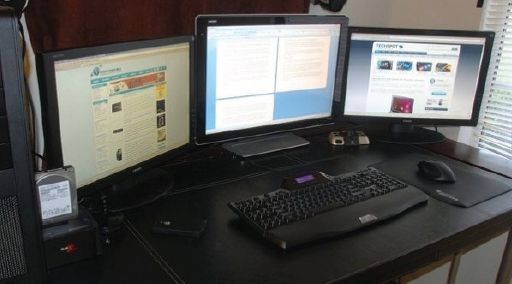
In most cases, power users use computers very similar to those used by gamers, although some power users who travel a lot prefer ultrabooks.

Something to know
An example of how computers have made people’s lives easier is to look at the late physicist, Stephen Hawking. Professor Hawking was a world-renowned, award-winning scientist who suffered from a motor-neuron disease that left him unable to walk and talk. However, thanks to computer technology, he was able to communicate with others and continue to do his ground-breaking research.
DISABLED USERS
The advances in modern technology have enabled people with disabilities to not only use computers, but to also use computers to make their daily lives easier. The type of computer and its requirements will depend largely on the type of disability and the needs of the user. It is, therefore, important to research the issue before buying a computer for a disabled user.
BUYING RECOMMENDATIONS
With all of this in mind, we can see that each computer user is unique and has different computer needs. As such, they will require different computer hardware.
The following table lists some recommendations for computer hardware, based on the type of user.
Table 2.2: Recommendations for computer hardware based on the type of user

In the chapters that follow, we will study the different devices in some more detail.
PRODUCTIVITY, EFFICIENCY, ACCURACY AND ACCESSIBILITY ISSUES
Computers are one of the greatest technological advances of the modern era. They bring a variety of advantages, such as helping to improve productivity and efficiency by enabling the completion of difficult and time-consuming tasks in a fraction of the time it would take a human to complete. An example of this can be seen when looking at a factory that produces cars. It could take anything from two months to two years for a person to assemble a complete car. This same task can be completed within 8 hours by simply using a computer.
Computers can be programmed to perform a task in a very specific way. This not only ensures that the task is completed in the quickest way possible, but also that the task is completed as accurately as possible. Another example of computers helping with accuracy can be seen when looking at a database. The computer program allows you to use formulas and functions to do calculations. If you would have to complete these calculations on your own, it would take a significant amount of time and you could run the risk of making mistakes.
The last advantage of computers that we will be looking at is the increase in accessibility. In the past, people with disabilities were limited in the way that they could communicate and complete tasks. Fortunately, computers offer solutions to these problems. Computers not only allow disabled users to communicate with others (through the use of special input devices); they also enable them to perform basic functions, such as driving a car.
 Activity 2.2
Activity 2.2
1.Write down the correct answer for each of the following questions.
a.Which one of the following is the abbreviation for the largest unit used to measure storage?
A.Gb
B.Kb
C.Mb
D.Tb
b.For which type of user is the following list of components intended: Core 2 Duo processor, 4 Gb memory, 500 Gb hard drive and a DVD reader?
A.Power
B.SOHO
C.Home
D.Disabled
c.An ultrabook is a preference for which travelling users?
A.Power
B.SOHO
C.Home
D.Disabled
d.Mobile users require a device that has which of the following features?
A.A large amount of processing power
B.A large amount of storage space
C.A long battery life
D.A high-definition display
e.Which of the following is NOT an example of a computer user?
A.Entitled
B.Home
C.Disabled
D.Mobile
2.Choose a term or concept from Column B that matches the description in Column A. Write only the letter next to the question number.

3.Say if the following statements are TRUE or FALSE. Correct the underlined word(s) if it is false.
a.The type of user that uses the most graphic processing power is a home user.
b.Stephen Hawking was a power user.
c.Screen resolution determines how much information you can view on a screen at a time.
4.Answer the following questions:
a.What are the different types of users? Give an example of a hardware component that is most important to each type of user.
b.What does the acronym SOHO stand for?
c.Which type of user uses the most processing power?
d.What is the difference between a SOHO user and a home user?
5.The following specifications appeared in an advertisement for a notebook computer. Study the specifications and answer the questions that follow.
Operating system – Windows 8
Processor – Intel 100 0M Celeron 1.8 GHz
Display – 15.6" (1 366 × 768), 16:9
Video graphics – Integrated Intel HD Graphics 4000
Memory – 4 Gb DDR3, 1 600 MHz memory
Hard disk – 160 Gb, 5 400 rpm
Optical drive – Integrated DVD reader
Sound – Integrated stereo speakers (2 × 1.5 W)
Integrated communications – 802.11n Wi-Fi, 10/100M LAN
Camera – 8 Mp webcam
1 × HDMI
1 × 12-in-1 card reader
a.Would this computer be suitable for a power user, such as a video-editing professional? Substantiate your answer by giving two reasons to support your answer.
b.Give two reasons as to why a notebook computer would be more suitable than a desktop computer for learners in a school.
UNIT
2.2 Input devices
To enable you to determine which hardware component suits your needs the best, we will focus on the main input, output, storage and processing devices; with special consideration of their uses, advantages and limitations, as well as other relevant characteristics.
To use your computer or cell phone, you will need an input device. An input device is a piece of hardware that enables a user to enter data into a computer, or interact with a computer. These devices allow you to interact directly with your computer (for example, a keyboard and mouse) and devices where the data is saved or transmitted to your computer (for example, scanners and cameras).
In the following sections, we will look at the keyboard and mouse, their advantages and limitations, as well as the risks associated with the devices. We will also give some advice on how to identify which device is best suited to your needs.
KEYBOARD
The keyboard is the most common and important input device for desktop computers. It consists of various keys that the user presses to give commands or type letters.
ADVANTAGES AND LIMITATIONS OF KEYBOARDS
Most modern computers come with a standard QWERTY keyboard. These keyboards have certain advantages and limitations, as described in the following table.
Table 2.3: Advantages and limitations of keyboards
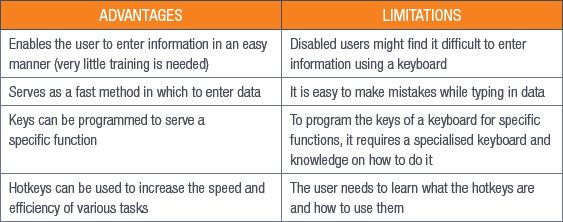

Something to know
Never use the kickstands underneath most keyboards.
ERGONOMIC CONSIDERATIONS
Any person who has worked with a computer for an extended period will know that most computer tasks require a keyboard and a mouse. It is, therefore, important to make sure that your keyboard and mouse are comfortable to use. Here are some factors to take into consideration regarding the ergonomic use of a keyboard:
- Make sure that your keyboard is at the correct height, just above the level of your lap. Your arms should be tilting downward when typing. In many cases, this may mean that you should get an adjustable keyboard tray so that your keyboard can be tilted down and away from you.
- Keep your wrists in the neutral (straight) position. If you have to bend your wrist up and down the whole time, it compresses structures in your wrists, and causes pain and injuries, such as carpal tunnel syndrome and tendonitis.
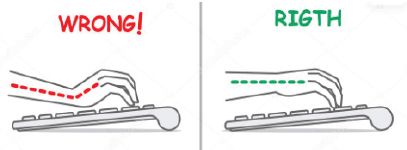
- Adjust the height of your chair to make sure that your elbows are at a 90-degree angle, or more. Elbows that are bent at less than 90 degrees can cause arm and wrist pain.
- Keep your shoulders relaxed and your elbows at your side. This means that your shoulders should not be raised and your arms should be roughly parallel to the floor.
- Keep a light touch on your keys when typing, as the tendons in your fingers are connected near your elbow. Hitting the keys too hard may cause inflammation of the elbows.
- Align your body to the keyboard, depending on whether you use the letters or the numbers the most. If you use the letters the most, centre the keyboard so that the letter B is about in line with your belly button. However, if you use your numeric keypad (or numpad) the most, move the keyboard more to the left.
- Use keyboard shortcuts or macros for common, repetitive tasks to prevent overusing your hands and wrists.
- Buy an ergonomic keyboard if you already suffer from hand, wrist, arm or shoulder pains.
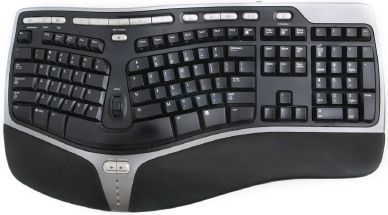

Something to know
Even though there are many types of mice available on the market, a standard two-button optical mouse will be more than sufficient for the average computer user.
MOUSE
The second most common input device to use with a computer is the mouse. A mouse is a pointing device. It allows the user to move the cursor on the computer screen, as well as point, click and select various programs and items. Although the Oxford Dictionary uses both “computer mice” and “computer mouses” as the correct plural forms of the term, we will be using the plural form “mice”.
ADVANTAGES AND LIMITATIONS OF THE COMPUTER MOUSE
There are very few computer applications that do not require a mouse to work. As such, computers are generally sold with a mouse and a keyboard. It is, therefore, important to take a look at the advantages and limitations of the computer mouse.
Table 2.4: Advantages and limitations of computer mice

ERGONOMIC CONSIDERATIONS
There are various health issues that can be caused by using a computer mouse, such as sore wrists, aching elbows and shoulders; all of which cause headaches. It is important to make sure that your mouse is correctly positioned and that you use it in the correct way.
Let’s look at the following tips on how to use a mouse ergonomically:
- Computer mice come in different sizes and shapes; therefore, make sure that the mouse fits comfortably in your hand and is easy to use. Rather use a symmetrical shaped mouse than a curved one.
- Do not grip the mouse hard. Hold it loosely.
- Make sure that you are holding your mouse correctly – i.e. rest your hand over the mouse and place your index finger on the left button of the mouse. You can rest your thumb and pinkie on the sides of the mouse.
- Keep your mouse at the correct height and distance from your body, close to the keyboard.
- Make sure that your elbow is bent and close to your body.
- Use your whole forearm, not only your hand, to move the mouse. If you move only your hand, it will put strain on your wrist.
- Keep your wrist straight. This will prevent your wrist from bending in an unnatural position.
- Do not use a wrist rest, as that doubles the pressure inside the carpal tunnel.
- Do not click too hard; rather use a soft touch to manipulate the mouse.
- Adjust the speed at which your mouse moves, the time required between double-clicks, and the size of the cursor if you have problems controlling the mouse.
TOUCH SCREEN
Unlike the keyboard and mouse, the touch screen serves a dual role as both an input and an output device. The touch screen allows the user to use his or her fingers, or a stylus, to directly press buttons and select options that appear on the screen.
The most common example of a touch screen can be seen when looking at any of today’s smartphones. From Apple to LG, each smartphone uses a touch screen to enable the user to easily navigate and use the various functions of the phone.
ADVANTAGES AND LIMITATIONS OF TOUCH SCREENS
While most modern smartphones rely exclusively on touch screens, there are also many notebooks and tablets that have touch screens.
Table 2.5: Advantages and limitations of touch screens

TOUCHPAD
The touchpad is a small square or rectangular input device on a laptop. It has the same function as a mouse. You use it by moving your finger across the pad to move the cursor on the screen. Like the standard computer mouse, the touchpad also has two buttons. The left button is used to select objects and the right button is used to bring up a menu. It also has a function that allows the user to scroll up and down a page.
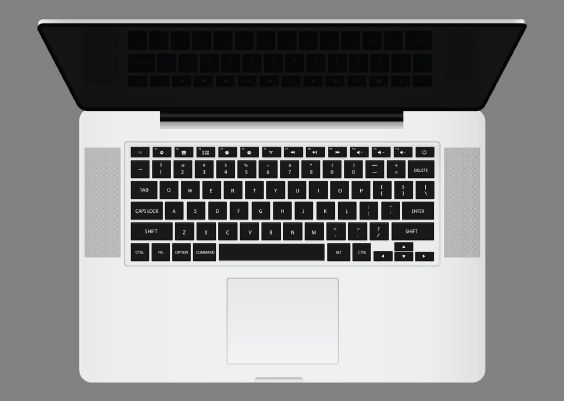
ADVANTAGES AND LIMITATIONS OF A TOUCHPAD
While touchpads are not an efficient way to move the mouse cursor, they make it possible to use notebooks without having to use any additional devices.
Table 2.6: Advantages and limitations of touchpads

DIGITAL CAMERAS
A digital camera is used to capture photographs and store them on a digital memory card instead of on film. Once the image is stored, you can transfer it to your computer. You can then manipulate (edit) the image, and print it or upload it to the internet. Some digital cameras can record video images with sound. An example of this is the camera in your smartphone.

Something to know
Digital cameras come packaged with software that allows you to edit photos by adjusting contrast and sharpness. The software can also be used to create and print photo albums. An example of digital camera software includes Digital Photo Professional and ZoomBrowser.
ADVANTAGES AND LIMITATIONS OF DIGITAL CAMERAS
Digital cameras have a number of advantages over the older film-based cameras. The biggest advantage is that you can preview the photo you take and delete the ones you do not want to keep.
Table 2.7: Advantages and limitations of digital cameras
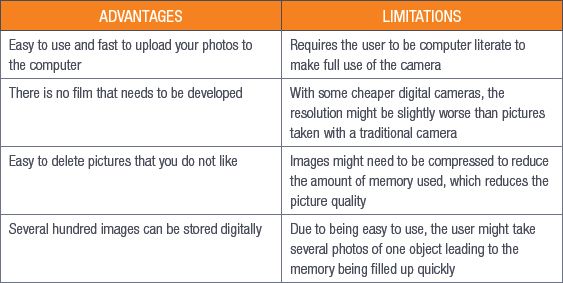

Something to know
It is important to remember that the more expensive digital cameras produce images with a high resolution and excellent quality.
RESOLUTION AND IMAGE QUALITY
As you have learned in Grade 11, resolution refers to the amount of detail that a camera can capture. The resolution is measured in megapixels. Generally, the higher the resolution, the clearer the photograph or video will be. A lower pixel count means that you can see the sharp edges of each pixel, which makes the image blurry (or pixelated).

One of the biggest advantages of a digital camera is that it provides the user with a choice of camera resolution and image quality. Although the average user will most likely want to take pictures using the high-resolution setting, you should know that there are some advantages to taking lower-resolution pictures.

Images with a lower resolution have a smaller file size and take up less space on a storage device. This saves time when you transfer images. It also saves money, as you can use devices with a smaller storage capacity. On the other hand, high-resolution photos have better image quality, allowing the user to crop the image as much as needed with little or no loss of quality.
WEBCAMS
A webcam is a type of digital camera that is connected directly to your computer. It makes it possible for the user to stream live videos to, or through the computer. The camera consists of a lens, image sensor and support electronics. Some webcams include a microphone, allowing you to record sound; others need a separate microphone. Laptops and notebooks have a built-in webcam and in most cases, a built-in microphone as well.
Once a video image is recorded on your computer, you can either save it on the same computer, or upload it to the internet (for example, to YouTube).
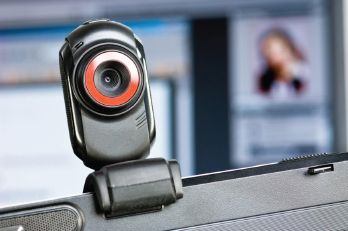

Something to know
Most webcams come packaged with webcam software, which allows the user to capture images and record videos. It also allows the user to adjust camera sensitivity and enable additional features, such as motion detection. Examples of webcam software include, Acer Crystal Eye Webcam and Logitec Webcam Software.
ADVANTAGES AND LIMITATIONS OF WEBCAMS
Webcams serve a variety of the following important functions in today’s society:
- They make it possible for a user to make and upload videos to YouTube and other social networks.
- They make it possible to have a face-to-face conversation with somebody who is far away. This feature is very helpful for business people, as they can have meetings with a group of people who are in different parts of the world. This is known as video conferencing.
Table 2.8: Advantages and limitations of webcams
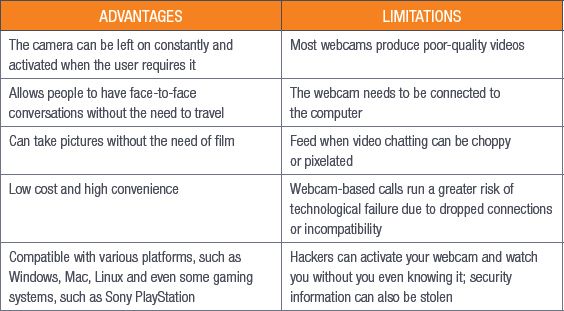
MICROPHONES
A microphone is an input device that makes it possible for the user to record sound, which is then stored on your computer. A variety of sounds can be recorded; including music, ambient sounds and your own voice.
You can use a microphone with a digital camera or webcam to make videos, to have a face-to-face meeting, or to have a discussion over a chat program, such as Skype.
ADVANTAGES AND LIMITATIONS OF MICROPHONES
While most notebooks and webcams have small built-in microphones, you should buy a specialised microphone if you plan to use your computer to communicate with your voice.
Table 2.9: Advantages and limitations of microphones

VOICE RECOGNITION
Voice-recognition (or voice-activation) software enables the computer to take verbal commands given by the user, and translate and interpret them. It does this by converting the audio received from the microphone to digital signals that the computer can interpret. The signals are then compared to a database containing words, phrases and actions that should be performed.
Over the last few years, voice recognition has become more common and part of our everyday lives. This can be seen by looking at the artificial assistants that can be found in your smartphone. Apple’s Siri and Android’s Bixby both work with voice recognition.
VOICE RECOGNITION FOR MARKETING
In 2017, Burger King in the USA made headlines when it began running a 15-second advertisement on television that specifically targeted Google home speakers and Android phones within earshot. The advertisement consisted of a Burger King employee looking directly into the camera, asking the question “OK Google, what is the Whopper burger?” This prompted nearby virtual assistants to start reading the burger’s Wikipedia entry.
However, Google quickly managed to prevent its home speakers to respond to the advertisement by registering the sound clip and then disabling the trigger. Although voices on the television have been found to trigger smart speakers, this advertisement was the first attempt by a company to purposefully hijack users’ devices for commercial gain.
Discuss the following questions in class:
1.Have you ever had your device’s information “hijacked” for commercial gain? If not, do you know anyone else to whom this has happened?
2.What do you think are the main disadvantages and problems that can be caused by voice-recognition software?
3.What are the advantages? See if you can come up with other examples where voice-recognition software is used to make life easier.
Table 2.10: Advantages and limitations of voice-recognition software
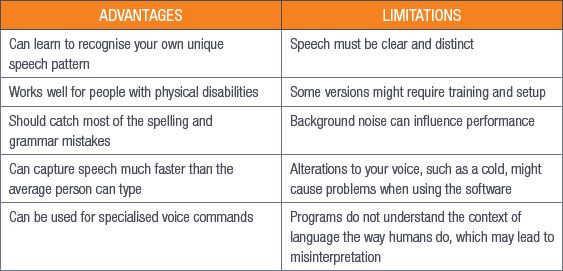
SCANNERS
A scanner is an input device that works a lot like a photocopy machine. However, unlike a photocopy machine, a scanner does not produce a printed copy of the scanned document; it produces a digital copy that you can save on your computer. When the document is in digital format, it can be edited and manipulated before you print it. Examples of scanners include the traditional flatbed scanner, as well as the more modern mouse scanner. The mouse scanner looks almost identical to a traditional computer mouse, but has the advantage that it allows the user to have a scanner at hand when needed. When the scanner is not needed, the mouse scanner can be used as a traditional computer mouse.
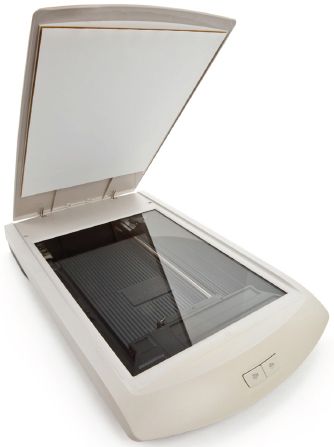

Something to know
Scanners are often packaged with optical character recognition (OCR) software, which converts the text on the scanned document, called a portable document format (PDF), to text that can be used in a word-processing application. This makes it possible for the user to edit a scanned document.
It should be noted that the effectiveness of OCR depends on the quality of the scanned document. Poor-quality scans will make it difficult for the software to function properly.
ADVANTAGES AND LIMITATIONS OF SCANNERS
Scanners are an important part of any office and can also be very useful for private use.
Table 2.11: Advantages and limitations of scanners
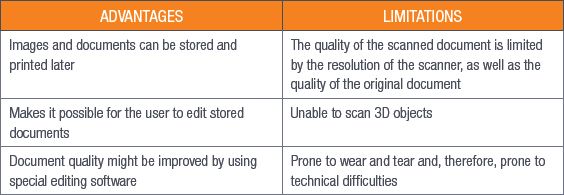
WIRELESS VERSUS CABLED DEVICES
Over the last 50 years, we have seen many advances in technology. Computers have gone from machines that take up whole rooms, to something the average person can afford and keep on their desk, or even in their pocket. Another advancement was made in the field of wireless technology.
Wireless devices, such as keyboards and mice, are similar to the standard wired versions. However, there are some factors to consider before you decide which type will work best for you.

Something to know
Wired input devices are connected via a wire to the computer, allowing information to travel between the two devices.
Table 2.12: Advantages and limitations of wired input devices

Wireless keyboards and mice use a receiver that is plugged into the USB slot on a computer. The input device then communicates with the computer, using a wireless transfer of data.
Table 2.13: Advantages and limitations of wireless input devices

From these two tables, you can see that both wireless and wired devices are similar, with only a few minor differences. The decision of which to buy ultimately comes down to your own choice and circumstance. If you have limited space or need to be able to work from across the room, wireless will be better. If you are on a budget or want to play games, wired will be better.
RISKS ASSOCIATED WITH INPUT DEVICES
The main function of any input device is allowing the user to interact with the computer. Due to this and the fact that most users spend a large amount of time using many of the devices, it is important to note that there are certain risks that you should be aware of. These risks include the following:
- Keystroke logging: This is a method used by hackers to record your keystrokes on the computer. The keystrokes can be used to identify personal information, such as bank details and passwords. Keystroke logging, also known as keylogging, is normally done with malicious software (malware) that is installed on your computer.
- Physical injury: The extensive use of a keyboard, mouse, trackpad or touchpad might lead to physical injuries, such as carpal tunnel syndrome, or repetitive strain injury.
- Pathogen transmission: If the input devices attached to a computer are used by a large number of people, it might play a role in the transmission of germs and other pathogens.
- Privacy issues: If a webcam and microphone are connected to your computer, a hacker might be able to gain access to them. This will then allow the hacker to gain access to your private images and conversations. As with keyloggers, this is usually done by malware that is installed on your computer.
INTEGRATION OF INPUT MODES TO ENHANCE PRODUCTIVITY AND EFFICIENCY
The integration of input devices is a good way to enhance productivity and efficiency. This means that having multiple input methods in a single device can help you to become more productive and efficient with what you do. The mouse scanner is a good example of technology integration, as it combines the traditional computer mouse with scanner technology. The result is a specialised computer mouse that has the ability to scan any size document up to A4, as well as being used as a point-and-click device.
Smartphones use integrated input modes to make users’ lives as easy as possible. These methods of input include the following:
- Touch screen: The touch screen can be used to play games, type messages and interact with programs.
- Microphone: The microphone can be used to talk to people, record messages and for voice recognition.
- Camera: The camera can be used to take pictures and videos, and to scan things like QR codes, as well as facial recognition.
On their own, each of these input devices serves an important function. When you combine them into a single device, you get one of the most popular devices the world has ever seen.

Something to know
It is not only the integration of input devices that enhances productivity and efficiency, but also the integration of, for example:
- Input/output devices: A four-in-one printer, which you can use to print, copy, fax and scan using just the one hardware device, is a good example of increasing productivity and efficiency with the integration of devices.
- Custom integrated software and input devices: Integrating an input device, such as a barcode reader and OCR scanner with an administration system (software), will save time, accuracy and provide comprehensive data during stocktaking or auditing and surveying.
 Activity 2.3
Activity 2.3
1.Write down the correct answer for each of the following questions.
a.Which of the following components can be used as an integration medium?
A.Keyboard
B.Camera
C.Touchpad
D.Standard computer mouse
b.Carpal tunnel syndrome is caused by too much pressure on the wrists. Which of the following devices is most likely to give you CTS?
A.Monitor
B.Printer
C.Mouse
D.Joystick
c.Which of the following is a limitation of voice recognition?
A.Can learn to recognise your own unique speech pattern
B.Background noise can influence performance
C.Should catch most spelling and grammar mistakes
D.Can be used for specialised voice commands
d.Which of the following is an advantage of the computer mouse?
A.The mouse requires a flat space close to the computer to operate
B.Uneven surfaces might affect the performance of the mouse
C.Disabled users might find it difficult to use both a keyboard and mouse
D.They are small and do not take much space
2.Choose a term or concept from Column B that matches the description in Column A. Write only the letter next to the question number.

3.Say if the following statements are TRUE or FALSE. Correct the underlined word(s) if it is false.
a.It is an advantage for disabled users who might find it difficult to enter information onto a keyboard.
b.Your wrist must be in a slanted position to use the keyboard correctly.
c.An optical mouse is very expensive.
d.The user must be computer literate to make full use of a digital camera.
e.A touch screen is an input and an output device.
4.Answer the following questions:
a.What is the difference between a touch screen and a touchpad?
b.What are two advantages of scanners?
c.How do integrated systems work?
d.How do wireless input devices work and what are two advantages of using them?
e.Which type of user will benefit the least from wireless inputs and explain why?
5.Read through and understand the following scenarios to provide an appropriate solution:
a.Since your father is technologically impaired, he came to you to explain to him what he must know before buying a webcam for work. List the advantages and limitations of a webcam.
b.Your parents decide to buy an entry-level computer with internet so that your grandmother can order her clothes and food online, and have them delivered. Explain to your grandmother how to use the keyboard and mouse ergonomically so that she does not suffer from pains. Give her at least seven tips.
UNIT
2.3 Storage devices
In the previous section, we looked at the various input devices that you can use to transfer data to your computer. To ensure that this data is not lost, your computer will need a storage device to store the data, which could either be an internal storage device, such as a standard hard drive, or an external storage device, such as a portable hard drive or flash drive.
To give you a better idea of which storage device is best suited for a specific situation, we will look at some of the most common storage devices, their advantages and limitations, as well as some of the risks associated with them.

Something to know
Storage devices refer to hardware that has a very specific purpose and function, i.e. to store data.


EVALUATING YOUR STORAGE DEVICE
When deciding to buy a new storage device, there are certain things that you must take into consideration. This includes the following:
- Its storage capacity, which determines how much information you can save on the device.
- Its storage speed, which determines how quickly new information can be written to the device, or read from the device.
- Its volatility, which determines if the device will lose the data when turned off. You do not want a device that will lose all its data in case of a power outage.
- Its reliability and durability, which determines how likely the device is to break down. When you store thousands of hours’ worth of work or years’ worth of photos on a storage device, you do not want it to break unexpectedly.
For internal hard drives, a storage speed of 7 200 revolutions per minute (RPM) is a good starting point, while the capacity will depend on your needs. For most people, 1 Tb should be enough storage space, although you may need more if you plan to store a lot of media files, such as music and videos.
INTERNAL HARD DRIVES
A hard drive is a piece of hardware in a computer in which data is stored and from which you can retrieve data. It is used to store files for your operating system, your software and personal information. Every modern computer comes equipped with an internal hard drive.
ADVANTAGES AND LIMITATIONS OF INTERNAL HARD DRIVES
Modern hard drives have the potential to store up to 12 terabytes (12 Tb) of data. This is enough space to store 3 000 000 compressed songs (such as MP3s), or 17 000 uncompressed CDs. However, these devices are not without fault.
Table 2.14: Advantages and limitations of internal hard drives


Something to know
When buying an external hard drive, make sure that you focus on the storage capacity. It is not worth buying a super-fast external drive if it contains a limited amount of storage. For the average user, a 1 Tb external drive will be sufficient. If you only want to back-up some documents and pictures, a flash drive might be a better choice.
EXTERNAL HARD DRIVES
Although most hard drives are located inside the computer, there are some that are used as portable storage devices. These are known as external hard drives. Unlike the internal hard drive, external hard drives are protected by a case that is designed to prevent damage to the drive and is connected to the computer by using a USB cable.
ADVANTAGES AND LIMITATIONS OF EXTERNAL HARD DRIVES
The small size and portability of external hard drives ensure that they can be quickly connected to different computers and are, therefore, ideal for transferring large amounts of data, or backing up data from your internal hard drive.
Table 2.15: Advantages and limitations of external hard drives
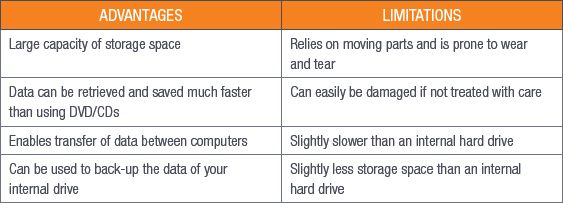
WHY IT IS IMPORTANT TO BACK-UP YOUR DATA
Tinu is a very busy guy with many social obligations. Due to this, he has been putting off writing his ten-page essay on “Why YouTube is amazing”. He knows that he is more than capable of writing this essay in one day; so, he waited until the afternoon before his essay was due. Six hours into writing the essay, there was a minor power surge and Tinu’s computer restarted. After the computer started up again, Tinu realised that he forgot to save and most importantly, back-up his work, and that he had to start all over again. Due to this, Tinu rushed his writing and barely finished in time, producing a very poorly written essay.
This example might seem like a minor inconvenience as Tinu still managed to finish his essay in time. Just imagine, however, you have been saving all your photos of family vacations and special moments on your computer, without backing them up on another storage device or medium. A big power surge hits your computer and causes your hard drive to stop working. You have now lost the reminders of all those precious moments. This can be prevented by simply backing up your data.
Backing up data is a simple process where you make a copy of important data on a separate storage device. This device can then be kept at a different location and used to restore any lost data. Traditionally, external hard drives, flash drives, CDs and DVDs are used to back up information.
Discuss the following questions in class:
1.Have you lost important information due to not backing it up?
2.How did that make you feel and what was the impact of it on your life?
3.What could you have done differently?
4.Are you backing important information up? On which device and how do you keep that device safe?
SOLID-STATE DRIVES
The SSD is a storage device (like a hard drive) that does not use the traditional mechanical parts of standard hard drives. Instead, the drive consists of interconnected flash memory chips made of silicon. Due to this, an SSD functions more like a CPU that contains billions of small transistors; each storing one bit of data.
ADVANTAGES AND LIMITATIONS OF SOLID-STATE DRIVES
Solid-state drives, or more commonly referred to as SSDs, are generally many times faster than normal hard drives. However, since a separate transistor is needed for each bit of data stored, SSDs also usually have a much lower storage capacity and a much higher cost per gigabyte. It is, therefore, recommended that you use an SSD to improve the performance of certain programs and not as a primary storage device.
Table 2.16: Advantages and limitations of SSDs
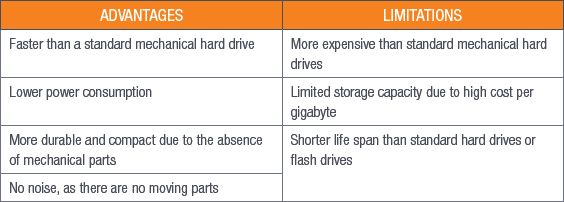

Something to know
For the average user, an SSD of 128 Gb will be more than enough. We recommend that you use a standard mechanical hard drive to store large amounts of data. Something to know

Something to know
Flash drives usually have a storage capacity between 4 Gb and 512 Gb, although both bigger and smaller flash drives exist. Something to know
FLASH DRIVES
A flash drive is a very small (physically) portable storage device. You can connect it to your computer via a USB port. Because it is so small and highly portable, a flash drive is the best way to transfer data quickly and efficiently between two computers. A flash drive is also an ideal storage device for documents and photos.
ADVANTAGES AND LIMITATIONS OF FLASH DRIVES
Flash drives have a very high cost per gigabyte. Due to this, we recommend that you base your purchase on the amount of data that you want to transfer or store.

Something to know
The flash drive is also referred to as a thumb drive, USB stick, memory stick, or flash stick. Something to know

Something to know
CDs have a storage capacity of 700 Mb, DVDs have a capacity of 4.7 Gb and Blu-ray discs have a capacity of 50 Gb.
Table 2.17: Advantages and limitations of flash drives

OPTICAL DISC DRIVES
An optical disc drive is a multi-purpose drive that makes it possible for the user to either read data from optical discs, such as compact discs (CDs), digital optical discs (DVDs) and Blu-ray discs (BDs), or to record data. This, as well as the fact that most movies and music are supplied commercially on these discs, an optical disc drive is one of the most popular storage devices.
ADVANTAGES AND LIMITATIONS OF OPTICAL DISC DRIVES
One of the major advantages of an optical disc drive is that it gives the user an affordable and time-efficient way of producing multiple copies of a disc that contains information. However, due to the limited storage space, this is restricted to small amounts of data.
Table 2.18: Advantages and limitations of CDs/DVDs


Something to know
Most optical disc drives are compatible with their predecessors. For example, a DVD drive can read both DVDs and CDs, and a Blu-ray drive can read Blu-ray discs, DVDs and CDs.
CAPACITY AND COST OF THE MOST COMMON STORAGE DEVICES
Throughout this unit, we have taken a basic look at the some of the most commonly used storage devices. We have discussed the advantages and limitations of each device, and have given some indication of which device will be suited for a specific task.
Table 2.19 gives a summary of the capacity and cost of these devices, as well as for which task they are best suited.
Table 2.19: Cost, capacity and application of storage devices
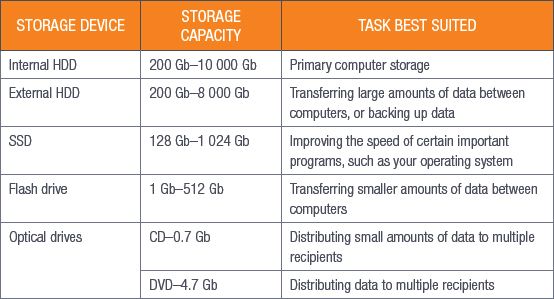
CLOUD STORAGE
One of the advantages of living in the modern world is the luxury of the internet. This global network makes it possible to communicate over great distances. It also provides access to vast amounts of information. The internet has also become one of the best places to store your personal data through cloud storage.
Cloud storage is a type of storage service provided to users that allow them to store information on the internet. The two best known services is Apple’s iCloud and Google’s Google Drive. Both provide users with a specific amount of storage at no charge (5 Gb for iCloud and 15 Gb for Google Drive), although additional storage space can be purchased at a monthly fee.
Table 2.20: Advantages and disadvantages of cloud storage

 Activity 2.4
Activity 2.4
1.Write down the correct answer for each of the following questions.
a.What current technology is replacing the DVD?
A.Flash disk
B.HDD
C.Blu-ray
D.CD
b.What is the average capacity of a DVD?
A.700 Mb
B.125 Gb
C.4.9 Gb
D.4.7 Gb
c.Which of the following is NOT a storage device?
A.HDD
B.RAM
C.SSD
D.USB stick
d.Which one is an internal hard drive’s average rotational speed?
A.3 600 rpm
B.7 200 rps
C.7 200 rpm
D.8 400 rps
e.Which of the following is a limitation of an internal hard drive?
A.Data can be retrieved and saved much faster than from DVDs or CDs
B.Lacks portability, as they are fixed inside the computer
C.Permanent storage of data
D.Large capacity of storage space
f.Which of the following is a limitation of an external hard drive?
A.Large capacity of storage space
B.Lacks portability, as they are fixed inside the computer
C.Slightly slower than an internal hard drive
D.Slightly more storage space than an internal hard drive
g.Which of the following is an advantage of SSDs?
A.More durable and compact due to absence of mechanical parts
B.Longer life span than standard hard drives or flash drives
C.Less expensive than standard mechanical hard drives
D.Increased storage capacity due to high cost per gigabyte
h.Which of the following is an advantage of flash drives?
A.Low cost per gigabyte
B.Does not require a power source to be used
C.Difficult to lose due to physical size
D.Longer life span, as the flash memory in the drive can be used an infinite number of times
i.Which of the following is an advantage of optical drives?
A.Data transfer and access rate is higher than either hard drive or flash drive
B.To reuse the same disc requires special rewritable CDs and DVDs, which are less expensive
C.Discs are robust and cannot easily be lost or damaged
D.Certain CDs and DVDs can be used multiple times
j.Which of the following is NOT an advantage of cloud storage?
A.Accessibility
B.Reliability
C.Control
D.Disaster recovery
2.Choose a term or concept from Column B that matches the description in Column A. Write only the letter next to the question number.
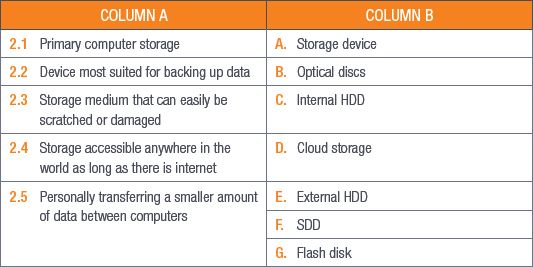
3.Say if the following statements are TRUE or FALSE. Correct the underlined word(s) if it is false.
a.Another name for a flash disk is a thumb drive.
b.A flash drive is the least robust storage device.
c.An internal hard drive has the highest storage capacity.
d.A hard drive has a shorter life span than an SSD.
e.Cloud storage is for free for a specific amount.
4.Answer the following questions:
a.What is the difference between an internal and an external hard drive?
b.What is the difference between an HDD and an SSD?
c.How would you explain cloud storage to a Grade 10 CAT learner?
d.What five points must you take into consideration when choosing a storage device? Explain these points briefly.
5.Read through and understand the following scenarios to provide an appropriate solution:
a.Your parents gave you R1 500 to buy a storage device for your computer. Explain the factors involved in your decision to either buy a hard drive or an SSD. State your choice at the end.
b.Your uncle wants to open up a store that sells music CDs and DVDs, as well as clean CDs. Give him advice on the relevancy and future of CDs and DVDs. Give your opinion on whether or not it will be wise to open such a store and state why.
UNIT
2.4 Processing devices
The data received from an input device must be modified and changed before it can be sent to the computer’s output device. This is done by the computer’s processing devices through the implementation of certain instructions and calculations.
In this section, we will take a brief look at the most common processing devices. This includes the CPU, GPU and RAM. We will also provide some guidelines on how to determine which processing device is best suited for you.
CENTRAL PROCESSING UNIT
The CPU is one of the most important parts of any computer. It is responsible for the following tasks:
- Receiving and carrying out the computer’s instructions
- Allocating more complicated tasks to other chips that will better handle the task
The CPU functions by using billions of microscopic transistors that can each be switched on or off individually. As the name suggests, it is the core or centre of any computer.

EVALUATING A CPU
When trying to decide which CPU is best suited for your needs, you should consider the following:
- Gigahertz of the processor: Gigahertz refers to the CPU frequency and is an indication of the processor’s speed. As a general guideline; the higher the frequency, the better the CPU.
- Number of cores: As with the processor speed, generally more cores are better.
However, as with many of the other factors, this is not a fool-proof method, as computers with the same number of cores and the same gigahertz can operate at very different speeds. The best advice is, therefore, to research CPUs on the internet and find the best CPU in your price range.
Table 2.21 and Table 2.22 give a summary of some of the most commonly used CPU models.
Table 2.21: Celeron and Core processors

Table 2.22: Ryzen processors


Something to know
Take note that even though the Core i7 is faster than the i5, it is also a lot more expensive. For the average user, this difference in speed will not be noticeable and as such, the i5 is much better value for your money.

INTEL VS AMD
GRAPHICS PROCESSING UNIT
The GPU is a specialised processing unit responsible for display functions. Like the CPU, the GPU is responsible for making calculations and following instructions. However, unlike the CPU, the GPU’s instructions are limited to the calculations needed to render and display images on the screen.


Something to know
In modern 3D games, thousands of objects can appear on the screen at the same time. Each object is a complex shape with its characteristics determined by using mathematical formulas. For example, to ensure that a 3D world looks realistic, the GPU may calculate thousands of beams of light that bounce around the world to create the light and shadows of the scene. This requires billions of calculations per second, and, as a result, GPUs often have more processing power than CPUs.
EVALUATING A GPU
When you try to decide which GPU is best suited to your needs, ask yourself the question: “What am I going to use my computer for?” If your answer is “general use”, such as email, word processing and photos, then you might not even need to purchase a GPU. Most modern computers come equipped with a fairly powerful onboard GPU that is more than capable of performing the actions needed by the average computer user. However, if you plan to use your computer for graphically intensive tasks, such as graphic design or gaming, you will definitely have to consider an advanced GPU.
Unfortunately, buying an advanced GPU is not as easy as it sounds. There are various manufacturers that have a variety of products with different specifications. To find the correct product for your needs, you have to look at the manufacturer’s model numbers and benchmarks. Looking at the model number will provide you with an indication of which generation the card is, while the benchmarks will show you how powerful it is.
Table 2.23: An example of GPUs
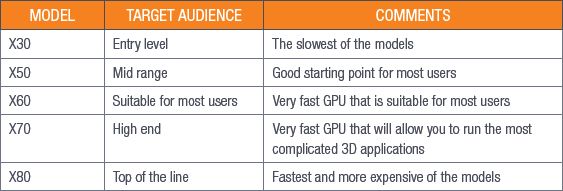

HOW DO GRAPHICS CARDS WORK?
With these model numbers, the X is replaced by a number that refers to the generation of the graphics card. For example, the GTX 980 was released in March 2015; while the GTX 1080 was released one year later in May 2016. This model was followed by the RTX 2080 that was released in September 2018.
While these model numbers and the patterns behind them may change, spending a few minutes to understand what the different numbers mean, will allow you to pick a graphics card suited for you at an appropriate price.

Something to know
The GPU is also referred to as the display adapter, graphics card, video adapter, video card, video controller or even gaming card.
RANDOM ACCESS MEMORY
RAM is a piece of hardware (chip) responsible for temporarily storing data. It also enables the computer to work with a vast amount of information at the same time. It does this by acting as a helper to the GPU and CPU, storing the information that is currently being used, and loading the data that they may want to use next.

Something to know
RAM can be as much as 90 times faster than the fastest storage devices.

EVALUATING RAM
To be able to both store data and load new data fast enough to let the GPU and CPU operate without any interruptions, RAM needs to me much faster than any other storage device. Having a processor that can complete four billion instructions per second is not useful if it cannot be provided with four billion instructions each second. It is, therefore, very important that your computer is equipped with enough memory to allow the GPU and CPU to operate at their full potential.
Determining how much RAM is needed will depend on the following two main factors:
1. Which operating system are you using?
2. What are you planning to do with your computer?
Table 2.24: Recommendations with regards to RAM


Something to know
Take note that your motherboard will determine which type of RAM you will need to buy. The most common varieties include the following:
- DDR2 SDRAM: This RAM is normally found in older computers. It was succeeded in 2007 by the DDR3 SDRAM.
- DDR3 SDRAM: This RAM is normally found in computers made after 2007. It was succeeded in 2014 by the DDR4 SDRAM.
- DDR4 SDRAM: This RAM is found in most modern computers.
The best advice is to do some research on the internet to find out which RAM will work best with your motherboard.
 Activity 2.5
Activity 2.5
1.Write down the correct answer for each of the following questions.
a.How much faster can RAM be than the fastest storage device?
A.90 times
B.80 times
C.70 times
D.100 times
b.Most modern computers use this type of RAM.
A.DDR2 SDRAM
B.DDR3 SDRAM
C.DDR4 SDRAM
D.DDR5 SDRAM
c.Which amount of RAM is recommended for a professional user?
A.32 Gb
B.16 Gb
C.8 Gb
D.4 Gb
d.Which of following can be used to decide on a CPU?
A.The amount of heat produced
B.Number of pins
C.Number of cores
D.The amount of data that can be stored
e.Which of the following is responsible for temporarily storing data?
A.RAM
B.GPU
C.CPU
D.HDD
2.Choose a term or concept from Column B that matches the description in Column A. Write only the letter next to the question number.

3.Say if the following statements are TRUE or FALSE. Correct the underlined word(s) if it is false.
a.A home computer or entry-level user does not need a GPU.
b.All types of RAM fit on any motherboard.
c.A GPU is the core of any computer.
d.A GPU is located on the motherboard.
e.The more cores a CPU has, the more prone it is to gain heat and slow down the processing speed.
4.Answer the following questions:
a.For what is the CPU responsible?
b.What must you consider when evaluating a CPU?
c.What is the difference between a CPU and a GPU?
d.What is RAM and what does it do?
e.What must you consider when evaluating a GPU?
UNIT
2.5 Output and communication devices
In the previous unit, we looked at the devices that feed data into your computer, the hardware that is responsible for storing the data and the hardware that processes the data. We will now take a closer look at some of the most common devices that are used to present the processed data to the user, or to other computers and networks.
OUTPUT DEVICES
An output device is any device that takes the data that has been stored on a computer and makes it available to the user. This can be done visually (such as, a computer screen or printer), or auditory (such as, speakers).
COMPUTER SCREEN
The computer screen or monitor is the most important output device of any computer. It makes it possible for the user to visually interact with data and programs in a quick and easy manner. This is possible because the computer software is built around a visual representation of data; whether it is a page of text, video on the internet, or 3D elements in a game.
EVALUATING A COMPUTER SCREEN
When looking to buy a new computer screen, there are three main things to look at:
1.Pixels: A good number of pixels is 1 920 pixels across the width of the monitor and 1 080 pixels across the height of the monitor. This is normally represented by the resolution of the screen as 1 920 × 1 080, or full HD – i.e. the higher the number of pixels, the better the screen.
2.Screen size: The size of a computer screen is measured diagonally from the bottom of the screen to the top right. The measurement is made in inches and one inch is roughly 2.5 cm long. When looking at the size of the computer screen, you should take into consideration how big your desk is. A big screen can cause eye fatigue and even damage to your sight if not placed at the correct distance from your face. Any screen bigger than a 27-inch monitor will be too big for a normal-sized desk.
3.Refresh rate: This refers to the amount of time it takes for the screen to be updated with the newest information. It is normally represented as the number of times the screen updates in one second. Most modern computer screens have a refresh rate of 60 Hz. This means that the screen is updated with new image information 60 times in one second. This should be more than sufficient for most users. However, there are advanced screens available that have a refresh rate of up to 144 Hz. These screens, like those with a higher number of pixels, will be much more expensive.

Something to know
Modern monitors can have up to 3 840 × 2 160 pixels (called “4K” resolution). This, however, can be an expensive purchase.
VIRTUAL REALITY
Virtual reality or sometimes abbreviated as VR, is one of the most exciting and interesting advances of technology. It is a type of output device that uses a specially designed headset to fully immerse the user in a high-quality 3D virtual world using both sight and sound.
What sets virtual reality apart from other 3D viewing devices is that it is not limited to just normal 3D images. The virtual reality headset adjusts your vision, depending on where you look in real life, changing the picture you see as you look at different things. This gives the device a much more realistic feeling.
Discuss the following questions in class:
1.Who in your group has experienced virtual reality? How does it feel?

2.Would you like to have virtual reality available to you? Why or why not?
3.Apart from gaming, what else can virtual reality be used for? Do some research on the internet and find at least five different applications.

VIRTUAL REALITY
SPEAKERS
Speakers are one of the most popular output devices. They play back the sound on your computer. This makes it possible to listen to music, speak to friends over Skype, or watch movies.
EVALUATING COMPUTER SPEAKERS
Most computers have their own built-in speakers, which are fine for hearing the normal computer sounds. However, if you want to listen to music, movies or games, you should get additional speakers. The easiest option is to buy a set of computer speakers that you can just plug into the audio jack on the computer.
Let’s take a look at some of the following tips of what to look for when you buy speakers:
- Speakers with or without a subwoofer (2.0 or 2.1 speakers): A subwoofer is a loudspeaker designed to reproduce low-frequency sound (for example, bass sounds). Table 2.25 compares speaker systems with and without subwoofers.
Table 2.25: Comparison of a 2.0 and 2.1 speaker system

- Specifications and sound quality: The best way to evaluate the quality of sound produced by the speakers is to go and listen to them. If that is not possible, do your research on the internet and read the reviews of sources you trust. A good speaker system usually provides a good balance between the treble (high), mid-range and bass (low) frequencies; producing a full, rich sound while keeping the detail.
- Input: Look for a system that gives you more than one audio-input jack so that you can also plug in your iPod, smartphone, or other audio devices.
- Control: Although the systems that provide no control are the cheapest, it is better to get a system with at least a volume control. Some systems let you adjust the bass and treble levels as well. When you buy a system with more controls, make sure that they are easy to reach.
- Appearance: Make sure that you like the way the speakers look, as you are going to see them whenever you are sitting at your computer.
- Price: It is mostly true that the more you pay for speakers, the better they are. However, make sure that you shop around, as speakers are some of the most discounted computer accessories around.
PRINTERS
A printer is a device that makes it possible to transfer text and graphic output data from your computer to a piece of paper. You can print pages of text, illustrations, diagrams and photos.
WHICH PRINTER IS BEST FOR THE TASK?
When you buy a printer, it is very important to know what you will be using the printer for, since different printers are good at different things. If you are looking at printing only black and white documents, you do not need to purchase a colour printer, as it will cost more to operate. Other things to keep in mind include the following:
- Speed: Budget printers should be able to print about three to six colour pages per minute.
- Paper type and size: Make sure to select a printer based on the type of documents you have to print.
- Printer resolution: This is normally measured in dots per inch (dpi), and affects the sharpness of the text and images on the paper. A resolution of 600 dpi should be sufficient for the average user.
- Costs to print a page: Colour printers are more expensive to operate and will cost more per page. This is also true for printers with a higher resolution.
- Memory: All printers come with a limited amount of memory. Having more memory increases the speed at which printing takes place. This will only be noticeable if you are planning on printing pages with large images or tables on a regular basis.
- Wireless capabilities: Most modern printers come with Wi-Fi capabilities. This makes it possible for the user to print documents without the need to be physically connected to the printer.
- Ink cartridges: Make sure that ink cartridges are available for when you have to replace them.
COMMUNICATION DEVICES
A communication device is a type of device that connects a computer to other computers in a network. Examples of communication devices include internal equipment, such as a network or Wi-Fi card, as well as external equipment, such as a router.
Built-in communication devices are usually designed to communicate with a very specific type of network. For example, a computer network card will either allow you to connect using a physical ethernet cable, to a Wi-Fi network, or to the internet. In contrast, the purpose of a networking device, such as a router, is to connect many different types of networks, so that it may connect devices using ethernet cables, Wi-Fi, DSL and 3G on the same network.
 Activity 2.6
Activity 2.6
1.Write down the correct answer for each of the following questions.
a.What is the refresh rate of a computer screen measured in?
A.Frames per minute
B.Hz
C.rpm
D.m/s
b.What is the most limiting factor when buying an output device?
A.Cost
B.Performance
C.Quality
D.Durability
c.Which of the following is NOT an output device?
A.Speakers
B.Virtual-reality glasses
C.Scanner
D.Touch screen
d.Which of the following is an important factor when buying a printer?
A.Power usage
B.Size
C.Memory
D.Lens quality
e.Which of the following is NOT a factor when buying speakers?
A.Input
B.Control
C.Appearance
D.Storage
2.Choose a term or concept from Column B that matches the description in Column A. Write only the letter next to the question number.
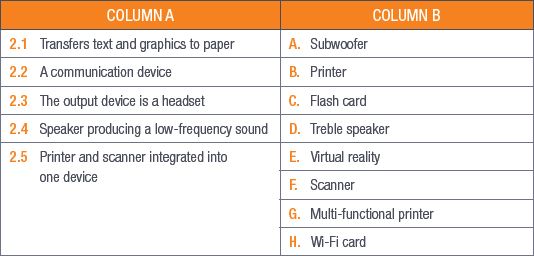
3.Say if the following statements are TRUE or FALSE. Correct the underlined word(s) if it is false.
a.The bigger the screen size, the better it is for your eyes.
b.When a screen is described as 1 920 × 1 080, it means that the screen has 1 920 pixels along the height of the monitor.
c.It is possible to listen to music on your computer without a dedicated sound card.
d.The price of any output device is always a factor when evaluating the output device.
e.Having more memory in a printer increases the printing speed.
4.Answer the following questions:
a.Define an output device and give three examples of it.
b.How does a speaker system with a subwoofer compare to a speaker without one?
c.What are the three most important aspects you must look at when buying a monitor?
d.What five aspects must you look at when buying a printer?
e.Virtual reality equipment is becoming more affordable. In what way can virtual reality be used? Name two pieces of equipment that one would need for virtual reality.
UNIT
2.6 Troubleshooting hardware devices
As with most things in life, computer equipment is not without fault. As hardware gets older, wear and tear sets in, leading to a variety of potential issues. To make your life easier (and hopefully save some money), we will be taking a look at some of the most common issues that you might encounter, as well as how to resolve them.
In this unit, we will look at some of the most common problems that people experience with their computers. We will also look at ways in which to solve these problems.
ERRATIC MOUSE MOVEMENT
Erratic mouse movement is one of the most common issues that might occur when you use a mouse. This happens when your mouse pointer starts acting erratically, jumping across the screen and does not move properly.
Let’s take a look at some of the possible causes and solutions to fix erratic mouse movements:
- The mouse is dirty: The performance of an optical mouse might be affected by dirt inside the mouse. Removing the dirt by cleaning the mouse should fix the issue. Be sure to look up how to clean the mouse properly before you do it.
- Bad surface: An irregular or shiny surface might interfere with the optical laser that is used by your mouse. This can be fixed by getting a mousepad or book to work on.
- Wireless mouse: If you are using a wireless mouse, the issue might be caused by low battery power. Replacing the batteries should fix the issue.
SCANNING
Scanning a document does not always produce the expected result. Let’s take a look at some of the most common issues that you might encounter, as well as their possible solutions:
- A skew or cut-off scanned document: This is caused by a document that is not properly aligned. To fix it, reposition the document on the scanner.
- Poor image quality: This can be due to two reasons:
- Caused by a dirty scanner surface: Cleaning the surface should resolve the issue.
- Caused by the inability of the OCR software to read the text: This can be fixed by making sure that the document you want to scan is clear and readable.
- Connection errors: This is most likely caused due to a poorly attached connection. Make sure to properly connect the scanner to fix the issue.
DISK ERRORS (DEFRAGGING)
Hard drives are prone to wear and tear, which can lead to a variety of problems, such as disk errors caused by disk fragmentation. Therefore, it is very important to regularly check the condition of the hard drives to make sure that they do not fail. In order to do so, you can do the following.
 Guided Activity 2.1
Guided Activity 2.1
1.Open your computer’s Start menu.
2.Enter “command prompt”. Then, click the Command Prompt option. You should now see a window open.
3.Type in the following command: “wmic diskdrive get status”. This command will look at the key health indicators of your hard drives and see if there are any problems.
4.Press Enter to see the status of your hard drive.
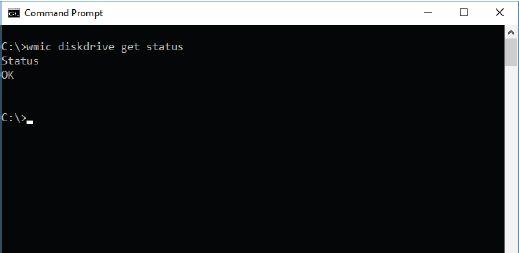
5.If you receive the “Status OK” message, your hard drives are in a good condition. If not, you should immediately back up the important files from your hard drive and try to replace it as soon as possible.
Another tool that you can use to maintain your hard disks is the Optimize Drives tool (previously called the Disk Defragmenter). This tool will help you to reorganise the way in which the data is stored on your hard drives (without changing any files), so that your drives can run smoothly.
 Guided Activity 2.2
Guided Activity 2.2
1.Open your computer’s Start menu.
2.Enter the words “optimize drives”.
3.Click the Defragment and Optimize Drives application. The Optimize Drives window should open.
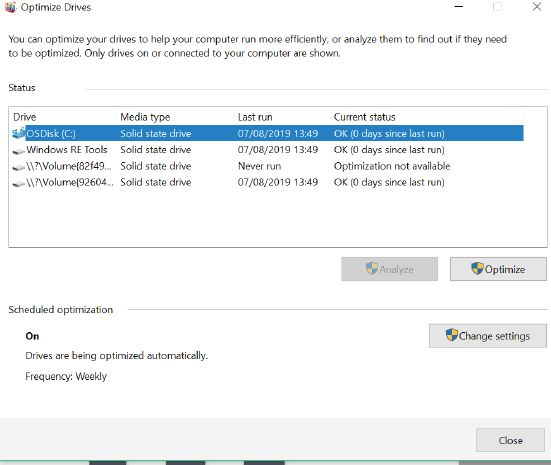
4.Click the Optimise button to begin optimising your hard drive.
5.At the bottom of the Optimise Drives window, the Scheduled optimisation should be enabled. If not, you can enable it by using the Change settings button.

Something to know
SSDs should never be optimised or defragmented. By default, Windows 10 will not attempt to optimise these drives.
RESOLUTION
As previously discussed, resolution refers to the number of pixels on the computer screen and plays an important role in determining image quality. We will now look at some of the most common resolution-related issues that you might encounter, as well as how to fix them.
Black screen:
- The screen is not plugged into the computer. Plugging in the screen should fix this issue.
- The setting of the screen resolution is too high. Operating systems, such as Windows, have a built-in feature that allows you to return to your previous resolution 15 seconds after you selected a new one. Just make sure that you do not click on Keep these changes.
- The images and text on the screen look very big. This is most likely because the resolution is very low and changing the resolution should fix the problem. This issue is sometimes caused when updating your computer’s graphics drivers.
 Guided Activity 2.3
Guided Activity 2.3
1.Open your computer’s Start menu.
2.Enter “display settings” and click the Change Display Setting option. You should now see a new window open. (The Display Setting window can also be opened by right clicking on your desktop and selecting the Display Setting option from the menu.)
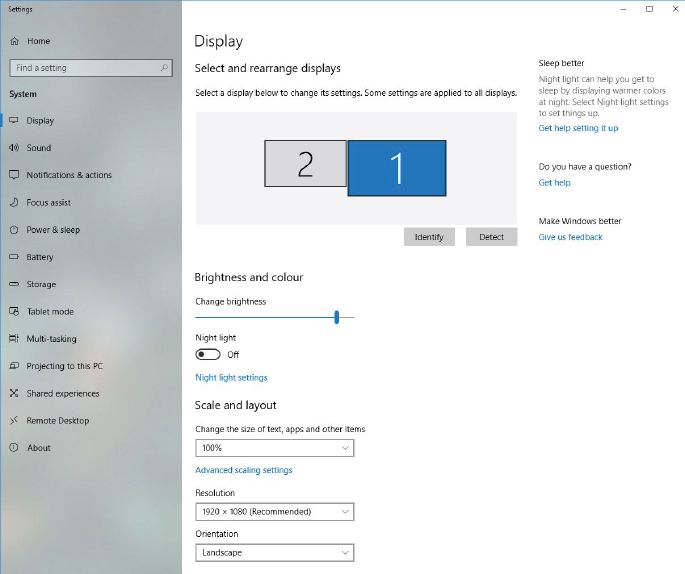
3.Scroll down to the resolution section and select an appropriate resolution from the drop-down menu. (There should be a recommended resolution that you can use.)
4.Click to keep these changes and close the Display Settings window.
5.If you encounter a black screen when changing the resolution, do not worry as Windows 10 has a built-in feature that allows you to return to your previous resolution 15 seconds after you have selected a new one.
NON-RESPONDING PROGRAMS, MOUSE AND KEYBOARD
One of the most common problems that you might encounter when working on a computer, is that the program you are using, stops responding. This might be caused by a variety of factors, such as faulty programs, your computer running out of resources, or faulty hardware. The best way to resolve this issue is to close the non-responding program and then to reopen it. However, it is difficult to close programs that are not responding, as they do not respond to clicking, or selecting the Close Program option.
 Guided Activity 2.4
Guided Activity 2.4
1.Open your computer’s Start menu.
2.Type in “task manager” and click the Task Manager option. You should now see a new window open. (You can also open Task Manager by pressing the Ctrl, Shift and Esc keys at the same time, or you can right click on the taskbar.)
3.Select the program that is not responding. There will be a list of all the programs that are currently running on your computer. Scroll down and select the non-responding program.
4.Click the End Task button. This should close the non-responding program.
5.Once the non-responding program has been closed, re-open it again.
PRINTING PROBLEMS
Printing problems is one of those things that every person will suffer through at least one point in their lives. Let’s take a look at the some of the most common printing problems and their possible solutions:
- Printing takes too long: This can be caused by a high-resolution setting, memory issues, or printer drivers.
- High-resolution images: High-resolution images require more data from your computer, which can slow the printing process down. This can be fixed by selecting the standard or normal mode. This also works to resolve memory issues.
- Printer software: Make sure that your printer software is updated. If not, updating the software could fix the issue.
- Paper jams: This is caused by a piece of paper becoming stuck inside the printer. To fix the problem, start by inspecting the paper path and removing any stuck papers.
- Bad printing quality: Check that your printer has enough ink or toner and that it contains the correct paper.
- Printer does not print: This might be caused by a bad connection, the printer running out of ink or toner, or the printer driver not being installed on your computer.
LACK OF FREE SPACE ON STORAGE MEDIUM
The storage on your computer is limited and as such, you might come across a message telling you that you do not have enough hard-drive space to copy, or save a file. This issue can be resolved by deleting some of the files that you no longer need. To determine how many files you should remove, look at the amount of free disk space that is currently available.
 Guided Activity 2.5
Guided Activity 2.5
1.Open your computer’s Start menu.
2.Enter “file explorer” and click the File Explorer option. You should now see a new window open.
3.On the left of the new window, click the This PC option. This will open a summary of all the hard drives in your computer.
4.The free available space should now be visible for each of your hard drives. It is displayed as 23.00 Gb free of 118 Gb.
CONNECTION PROBLEMS
If you are struggling to use your computer to connect to the internet, the problem could be caused by any one of the following:
- Your computer
- The network cable
- The router
- The internet cable
- The internet service provider (ISP)
The following table shows you how to identify the cause of the problem.
Table 2.26: Troubleshooting

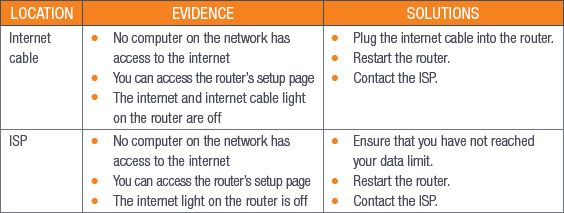
While network problems can be caused by a number of different devices, they are often easier to fix than hardware or software problems. Once a network has been set up correctly, most problems can be fixed by simply checking all the connections, restarting the affected computers and restarting the router. If this does not work, most ISPs have excellent support teams that should be able to assist you in resolving the problem.
 Guided Activity 2.7
Guided Activity 2.7
1.Write down the correct answer for each of the following questions.
a.What application do you use to close a non-responsive program?
A.Command Prompt
B.Task Manager
C.Settings
D.Disk Manager
b.The window of this option displays the available disk space on your computer.
A.System
B.Settings
C.This PC
D.Search
c.Which system settings allow you to change the screen’s resolution?
A.Power & Sleep
B.Sound Settings
C.Notifications
D.Display Settings
d.Which of the following will cause your scanned document to be of poor quality?
A.Inability of the OCR software to read the text
B.Clean alignment and shiny scanner surface
C.Poorly attached connection
D.Document too big for the scanner
2.Choose a term or concept from Column B that matches the description in Column A. Write only the letter next to the question number.
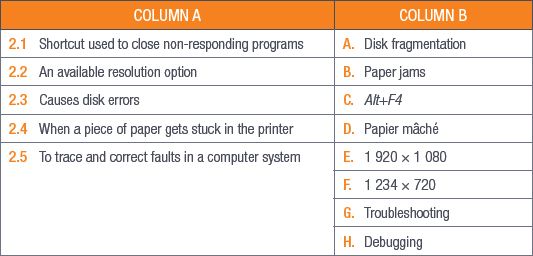
3.Say if the following statements are TRUE or FALSE. Correct the underlined word(s) if it is false.
a.An SSD should be defragmented once in a while.
b.A lower resolution makes the images and text look smaller.
c.A lack of disk space can slow down your computer.
d.SSDs should never be optimised or defragmented.
e.Having a higher screen resolution can slow down your computer.
4.Answer the following questions:
a.Give three possible causes to erratic mouse movement and how to fix it.
b.Describe three of the most common occurring scanning problems and the causes thereof.
c.What causes a black screen to occur?
d.You are a learner who has just finished writing a very important essay for an assignment. However, the printer that you are using to print the essay is not working. What could be causing this problem?
UNIT
2.7 New technologies
Computer technology is an ever-changing field. Each day, new technologies are developed to replace or improve existing technologies. The most powerful computing device today will not be the most powerful device tomorrow. This is part of what makes the fields of computers and technology so exciting.
Let’s take a look at some examples of technologies that were introduced in 2018 already:
- Holographic phone: This opened many new possibilities for communication as images could be viewed in 3D.
- 5G connections: This type of wireless connection greatly increased the speed of mobile communications, reduced latency and costs, and helped with energy savings.
- Blockchain technology: Blockchain technology has been around for several years, with the best known user of this technology being Bitcoin. However, it should be noted that this technology has the potential to change the ways in which we process and store data.
REVISION ACTIVITY
PART 1: MULTIPLE CHOICE
1.1Which of the following is an example of memory? (1)
A.RAM
B.HDD
C.SSD
D.GPU
1.2Which of the following is NOT a communication device? (1)
A.Router
B.Switch
C.USB flash
D.Wi-Fi card
1.3Which of the following networks would a home user use? (1)
A.WAN
B.LAN
C.HAN
D.WLAN
1.4Which of the following storage is NOT physical? (1)
A.Blu-ray disk
B.ROM
C.Cloud storage
D.Internal hard drive
1.5Which of these problems has to do with the computer’s software? (1)
A.The mouse is not responding
B.The computer is overheating
C.The computer cannot connect to the printer
D.The computer keeps freezing when you run a program [5]
PART 2: TRUE OR FALSE
Indicate if the following statements are TRUE or FALSE. Correct the statement if it is false. Change the underlined word(s) to make the statement true.
2.1SOHO users are people who work at home and in small offices. (1)
2.2A smartphone is ideal for a mobile user.
2.3When you use a keyboard, make sure that your elbow does not bend a lot. (1)
2.4 A digital camera captures photographs and stores them on an internal hard drive. (1)
2.5Cache is located on the hard disk, while RAM is located on the CPU. (1)
[5]
PART 3: MATCHING ITEMS
Choose a term or concept from Column B that matches a description in Column A. (5)
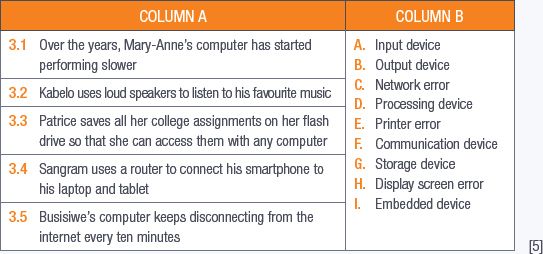
PART 4: CATEGORISATION QUESTIONS
Classify the following pieces of hardware as input, processing, output, or communication devices. (10)

PART 5: MEDIUM QUESTIONS
5.1Provide three examples of an input device that a paralysed person would use. (3)
5.2How do you access and use the Optimise Drives tool? (5)
5.3If you want to watch a video on YouTube, what hardware do you need? Mention ONE piece of hardware you will need for each step of the information-processing cycle. (5)
5.4 Which do you think is better, wired or wireless input devices? Give a reason for your answer.(2)
[15]
TOTAL: [40]
AT THE END OF THE CHAPTER

|
Previous
Chapter 1: General concepts
|
Table of Contents |
Next
Chapter 3: Software
|




